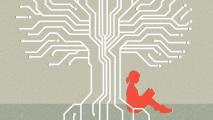When Emily Nix found out she would be teaching her University of Southern California economics course online this fall, she was worried.
“I had invested a lot of time to make my in-person class a good experience. I was most nervous about how to achieve the same level of engagement and enjoyment for the students but in an online environment,” she said.
Moving to an online classroom isn’t easy. Teachers can spend months preparing the materials and lesson plans for a course. Nix had already put a lot of effort into the class she teaches and refined over the years. She didn’t have time to start over. And she didn’t want to reinvent the course entirely.
Nix needed to find a solution — fast.
So, she studied evaluations from former students and reviewed videos taken of her while teaching to understand what works well. She found that she does a lot of “chalk and talk” — facilitating discussions while she writes on the blackboard — and began looking into options to recreate that.
One solution she looked into involved using an iPad to draw what she usually draws on the chalkboard. The students would see what she draws but have less face to face time. But that wasn’t good enough. According to Nix, seeing the individual while they are writing “adds so much dynamism.”
“I needed something that would be visually appealing, stimulate engagement, but be feasible to do in a reasonable amount of time,” she said.
Nix did what many people do when they are in a bind — she Googled. That is when she found the lightboard — a plexiglass sheet lit with LED lights. When Nix draws on the board, the words appear to glow in front of her. But, despite the simple design, a lightboard is expensive — as much as $8,000.
So, with only $60 in materials, Nix set out to build one of her own. She posted a short video of the results to her Twitter feed, which amassed a significant response. She has received messages from other professors seeking to create a lightboard of their own.
So far, the response to the lightboard has been positive, and Nix found that online teaching has unexpected upsides.
“There actually seems to be even more engagement and participation from students. With the online format, they can participate in many different ways. They can still speak “in person”, but they can also answer polls or type questions and answers in the chat,” she says.
“In the past, when I posed a question to the room maybe ten hands would go up, now if I pose a question and ask them to answer in the chat, I get something closer to 50% responding. That is incredible,” she says.
For Nix, the challenge of online teaching hasn’t stopped her from aiming high.
We’d love to hear from you! If you have a comment about this article or if you have a tip for a future Freethink story, please email us at [email protected].






